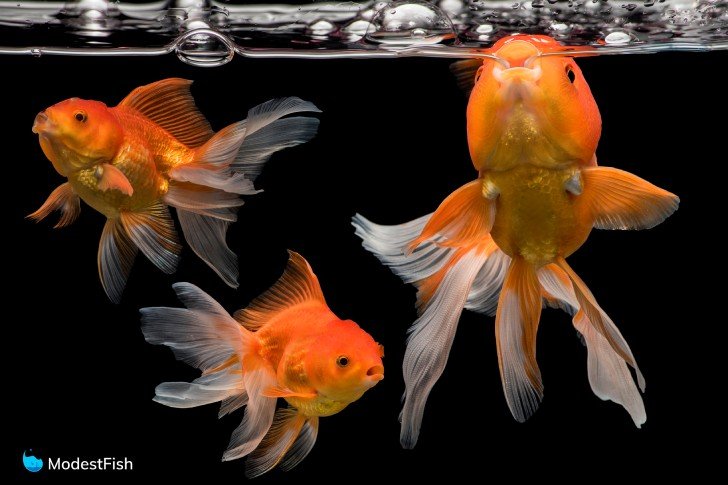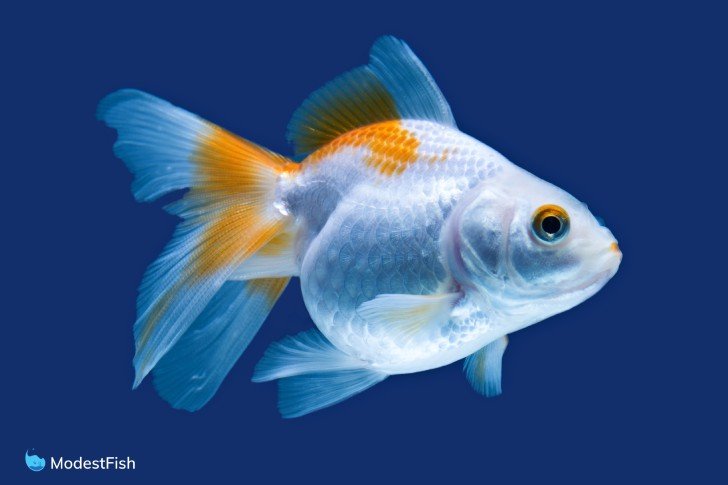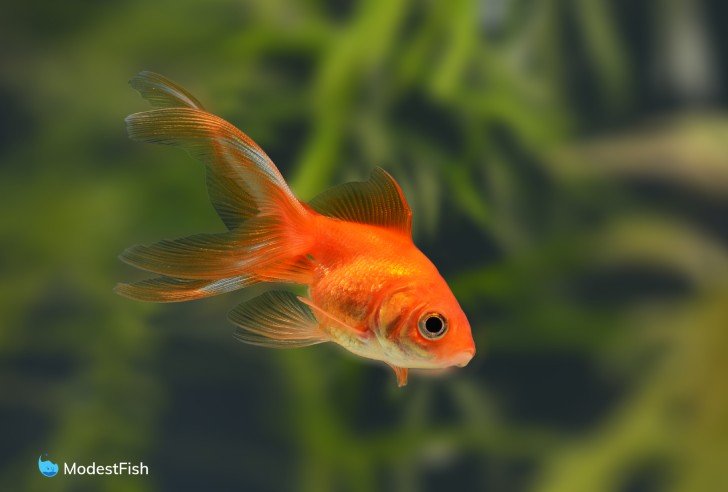The classic goldfish breed, the fantail, is what most people think of when it comes to keeping aquariums.
Caring for fantail goldfish can be pretty easy, as long as you have enough space.
In this guide, I’ll walk you through what is required to set up and run a successful fantail goldfish aquarium.
Quick Stats
- Care Level: easy
- Min. Tank Size: 40 gallons (151 liters)
- pH: 7.0-8.0
- Temperature: 65°-72°F (18°-22°C)
- Diet: omnivore
- Temperament: peaceful, but will eat smaller fish
- Lifespan: 10-15 years
- Size: 6-8 inches (15-20 centimeters)
- Family: Cyprinidae
- How many can be kept together: can be kept as a single or with as many others as the tank can accommodate
- Scientific Name: Carassius auratus
- Common Name: Fantail Goldfish
Appearance

This is the quintessential breed that I always think of when anyone says, “Goldfish.”
They have large, blunt heads with prominent eyes. Their backs curve upward from their heads and then swoop back down sharply to their tails.
Because of their curved spines, their abdomens swell out and give them giant pot bellies.
They have prominent dorsal fins and huge, showy, double tails that trail behind them like a bridal veil. Fantail Goldfish tails are twice the size of a common Goldfish’s tail.
Fantails also have showy, flowing pectoral fins.
They come in a variety of colors:
- White
- Calico (white with orange spots)
- Orange
- Blue
- Black
- Silver
- Gold
- Red
Fantail Goldfish Species Profile

In the Wild
Fantail Goldfish do not exist in the wild. They are the result of many, many generations of selective breeding of the common Goldfish.
In the Aquarium
Fantail Goldfish are one of the most common kinds of Fancy Goldfish. They are the result of decades of selective breeding in their native Asia.
They aren’t strong swimmers because of their large fins. They kind of bumble around the tank, inhabiting all levels of the water column.
Fantail Goldfish like to interact with their fishkeepers. They will come to the front of the tank to beg for a treat.
All Goldfish love to eat, and because of their voracious appetites, they poop quite a bit. Be prepared to perform 50% weekly water changes to remove waste.
These guys are mostly peaceful, but they will gulp down slow fish that are smaller than them.
They’re fairly easy to care for and are pretty hardy, living 10-15 years.
How to Set Up a Fantail Goldfish Tank

Tank Size
The minimum tank size for a Fantail Goldfish is 40 gallons (151 liters) for a single fish. You’ll need another 15 gallons (57 liters) of tank size for each additional Fantail.
You’ll see some sources that say Fantail Goldfish don’t need an overly large tank because they aren’t strong swimmers.
This is not correct.
Fantail Goldfish need a large tank not because of the swimming room necessarily, but rather because the larger volume of water can offset the fact that they produce so much waste.
Filtration
I can’t stress this enough, you need a great deal of filtration to keep up with all of the poop these fish produce.
Filters are such an important part of any fish tank, but especially when you have any kind of Goldfish.
Fish put off waste, in the forms of urine and feces. These sink to the bottom of the aquarium and start to break down. As the waste rots, it puts off ammonia.
And fish excrete ammonia directly into the water column through their gills.
Without a filter, the ammonia in the tank will build up in the water column.
Eventually, the fish won’t be able to clear the ammonia from their gills. When that happens, the fish start to get stressed.
As the ammonia levels climb, the fish’s gills start to get burned and they can’t take in oxygen.
All it takes is two drops of ammonia in 13 gallons (59 liters) of water to kill most species of fish.
Lucky for us, filters can be used to process fish waste and remove harmful compounds from the water that would otherwise kill our fish.
There is special media inside of filters, referred to as biomedia, that houses beneficial bacteria that eat ammonia and other harmful wastes. Ammonia is eaten and turned into something called nitrite. Nitrite is in turn then eaten and turned into something called nitrate, which is not toxic at low concentrations.
This process of turning ammonia into nitrite and then nitrate is known as the Aquarium Nitrogen Cycle. It is the single most important thing to understand in order to have success in fishkeeping.
I would recommend using redundant filtration in a Fantail Goldfish tank. I would pair a sponge filter with either a hang-on-the-back or canister filter.
Sponge filters are great for sucking up solid wastes and they provide an enormous amount of surface area for beneficial bacteria to grow on.
Please, see our in-depth articles about sponge, hang-on-the-back and canister filters.
Water Parameters
- Temperature: 65°-72°F (18°-22°C)
- Ammonia/Nitrite: 0
- Nitrate: <30
- pH: 7.0-8.0
- GH: 4-15 dGH
- KH: 3-8 dKH
Heater
In the aquarium hobby, Fantail Goldfish are referred to as cold water fish (as opposed to tropical fish).
Cold water fish do not require a heater. Most thrive in temperatures in the mid to high 60s.
So, no need for a heater unless your room temperatures drop below 65°F (18°C).
Substrate
Fantail Goldfish don’t need any particular kind of substrate. Some people even choose to keep their Goldfish in bare bottom tanks that don’t have any kind of substrate at all.
Bare bottom tanks make water changes easier because it’s simpler to see and remove solid wastes with a gravel vacuum.
But, if the bare bottom look is not for you, it’s no problem to use gravel, sand or baked clay substrate.
The only kind of substrate I would advise against using is a plant substrate that lowers the pH of your aquarium, for two reasons:
- Fantail Goldfish like alkaline water with a neutral to alkaline pH. Many planted substrates will drop the pH of the water and make it acidic.
- Goldfish, including Fantails, will destroy and eat plants. So, there’s no point in having an expensive plant substrate that messes with your water chemistry anyway.
Lighting
Goldfish don’t have specific lighting requirements.
You can just use whatever lights you like.
Plants and Decor
Plants are a no-go when it comes to Fantails. They will uproot and pick at plants until they are dead and destroyed.
If you want to try to mimic the look of a planted tank, but also really want Goldfish, you should consider getting some high quality artificial plants.
As far as decor goes, Fantail Goldfish don’t need caves or hiding spots really, so decor in their tanks is more about the viewing pleasure of the fishkeeper.
Sharp decor can damage a Goldfish’s long trailing fins, leaving the fish open to infection. Run your hand over decor pieces. If something seems overly rough or sharp, I’d skip it.
Fantail Goldfish Diet
These fish are true omnivores; they will eat anything that doesn’t try to eat them first.
They do best with a varied diet that includes both plant-based and meaty foods.
Fantail Goldfish also benefit from some added fiber in their diet. Fancy Goldfish, like Fantails, can easily get constipated because their curved spines compresses their internal organs.
Good sources of extra fiber include:
- Wheat germ
- Pea powder
- Banana powder
These should be counterbalanced with high quality proteins:
- Whole fish meal
- Shrimp meal
- Krill
Some excellent plant-based ingredients include:
- Algae meal – technically not a plant, I know, but this is the closest category it fits under.
- Spirulina – also not a plant. It’s a cyanobacteria that is loaded with easily digested nutrients.
- Marigold flower – color enhancing
- Turmeric – color enhancing
- Paprika – color enhancing
- Hibiscus flower – color enhancing
It’s best to feed Goldfish sinking pellets that they can scoop up from the bottom. They can accidentally swallow air when they grab food from the water’s surface. This can wreak havoc on their digestive system if they can’t expel the air.
For more information about feeding your Fantail Goldfish, please, see our in-depth article, here.
Fantail Goldfish Breeding
It can be quite an elaborate process to breed these fish.
The first hurdle is to figure out sex of your fish.
You can try to discern male from female several ways:
- Body shape – males are slimmer, and females carrying eggs will look slightly asymmetrical when viewed from above. This method can be unreliable. It only works if the females are carrying eggs.
- Breeding stars – when ready to breed, males develop small nodules of keratin on their pectoral rays, gill covers and/or scales. This method is also unreliable. Breeding stars are only present if the fish is ready to spawn. The rest of the year, they fade away.
- Behavior – the easiest way to tell male from female is by their behavior when they’re ready to breed. Males will persistently chase females, trying to press them up against the glass. But again, this only works when the fish are ready to spawn.
It’s also difficult to breed Fantail Goldfish in an aquarium setting because they will eat their own eggs and fry; you will need to have a separate tank to raise the babies in.
The most reliable method of getting babies from you Fantail Goldfish is called hand breeding.
Equipment:
- 2 plastic basins (16 inch/3 gallon)
Steps:
- When you start to see the male(s) chase female fish around the tank, it’s go time! Fill the basins with enough tank water that the fish can comfortably swim.
- Place a female and a male into one of the basins. Two males is even better, if you have them.
- Gently pick up one of the males. Flip the fish upside down and lightly rub his belly toward his vent. Milt should immediately start to stream out.
- Every few seconds, stir the water with your free hand to mix the milt evenly.
- Put the male back into the first basin.
- Gently pick up the female, flip her upside down in the basin with the milt. Lightly rub her belly toward her vent. Eggs should immediately come out in bursts with each stroke. If not, the female is not ready to spawn yet and needs more time back in the main tank.
- Make sure you stir the water after each small burst of eggs so they don’t stick together. This could deprive them of oxygen and cause them to mold.
- Place the female back into the first basin and collect milt from the second male.
- Repeat this process back and forth until the female stops putting out eggs.
- Place the parents back in their regular aquarium.
- The eggs will be stuck to the bottom of the basin. After about half an hour, swap out the water in the basin for fresh tank water.
To raise the fry, you’ll need to gently aerate the basin. The eggs should hatch in 2-4 days. The fry will live off their yolk sacs for about 2 days.
Once they are free-swimming, you can feed them baby brine shrimp.
For more information about breeding Fantail Goldfish, please, see our in-depth article, here.
Fantail Goldfish Tank Mates
The best tank mates for Fantail Goldfish are other Fancy Goldfish, assuming you have a large enough tank and enough filtration.
It can be tough to find tank mates for Fancy Goldfish because they will eat smaller fish if they get the chance, they can be easily bullied by faster swimming fish and they need to be kept in a cold water tank.
You also don’t want to mix them with fast swimming Goldfish, like Comet or Common Goldfish. Comets and Common Goldfish will snatch up all the food before the Fantail Goldfish have a chance to get it.
Quick fish are often good tank mates because they can easily outpace the slow swimming Goldfish.
Some possibilities are:
- Rosy barbs
- Giant danios
- Zebra Danios
- Platy fish
- White Cloud Mountain Minnows
Some good cleanup crew critters you might consider are:
- Banded corydoras
- Hillstream loaches
- Dojo loaches
- Bristlenose plecos
- Mystery snails
Is a Fantail Goldfish Right for You?
Fantail Goldfish are fun and enjoyable pets. I would say that the biggest concern about whether or not they are right for you is tank size.
You’ll need a fairly large tank to house this species and not everyone is willing to dedicate a tank that large to so few fish.
But, if you do have the space, I think these fish are great. I know they’re not the fanciest or most exotic fish on the market, but they’re active, interesting to watch and are just so darn cute.
They’re not difficult to take care of. Just remember to keep up with weekly water changes to keep your water clean.
I hope you find this article helpful.
I wish you and your fish the very best!
